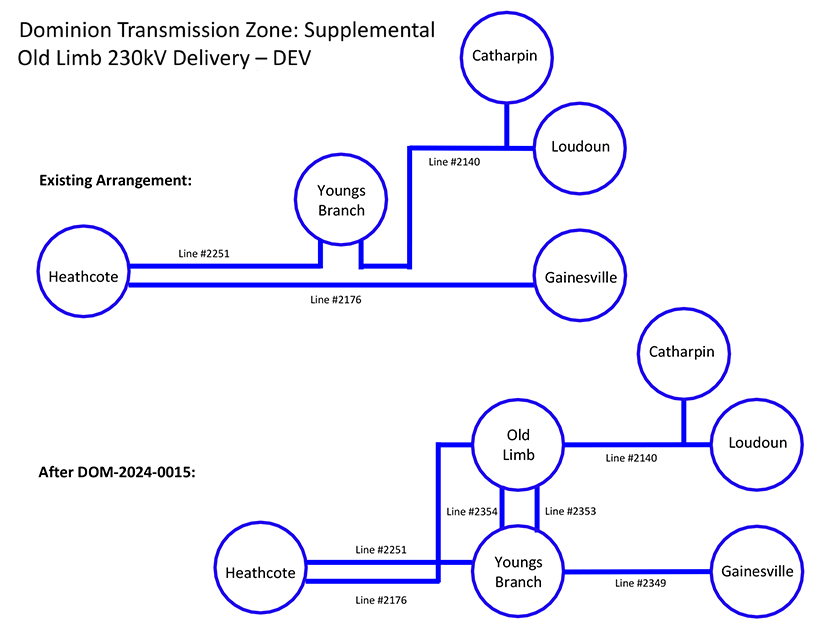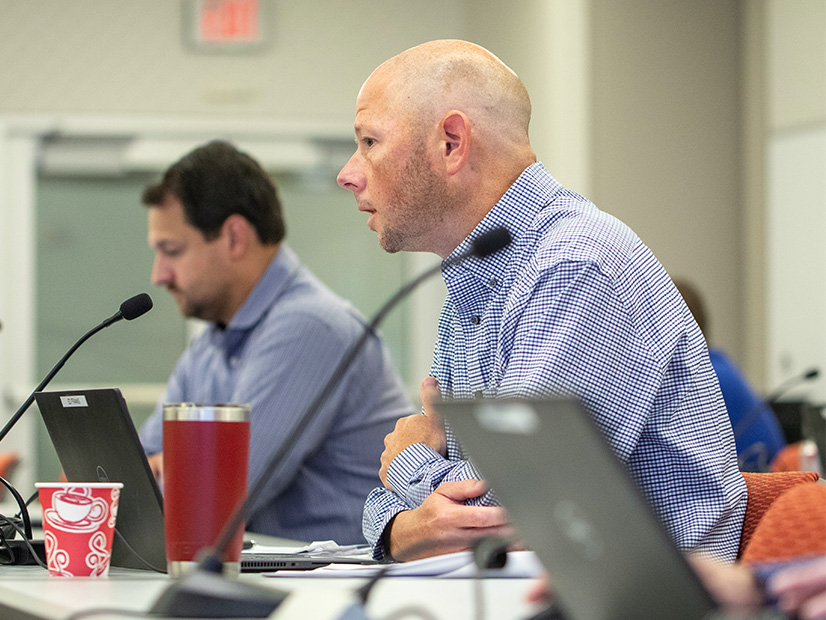VALLEY FORGE, Pa. — The PJM Planning Committee and Transmission Expansion Advisory Committee meetings were originally scheduled for Sept. 10 but were rescheduled to Sept. 12 and 13, respectively.
Planning Committee
Voting on CIR Transfer Proposals Deferred to October
The PC on Sept. 12 voted to defer action on three proposals to rework the RTO’s process for transferring capacity interconnection rights (CIRs) from a deactivating generator to a new resource. The committee will vote on them at its next meeting, currently scheduled for Oct. 8.
Each of the packages is aimed at creating an expedited process to shift the transmission capability underlying the CIRs of a retiring unit to support the interconnection of a new resource. Proponents of the concept say it could alleviate the need for costly reliability-must-run (RMR) contracts to keep resources online while upgrades are made to the grid to pre-empt any transmission violations prompted by removing a generator.
The vote was delayed after the committee rejected an amendment to a proposal sponsored by Elevate Renewable Energy and the East Kentucky Power Cooperative. (See “Elevate Reviews CIR Transfer Proposal,” PJM PC/TEAC Briefs: July 9, 2024.)
The amendment, proposed by MN8 Energy, would have added thermal violation analysis to the studies to be conducted on projects seeking CIR transfers and expedited interconnection. MN8 had withdrawn its own package ahead of the meeting and thrown its support behind the Elevate-EKPC coalition.
The MN8 amendment would have required thermal studies on the peak and off-peak deliverability cases, but Elevate’s Tonja Wicks said the coalition could only accept studies on the off-peak case.
The issue of thermal studies gets to the heart of whether storage resources should be eligible for CIR transfers, with PJM arguing that the capability to charge off the grid could pose “material adverse impacts” not envisioned by the original interconnection studies conducted on the deactivating generator. The PJM proposal would outright disqualify storage and open-loop hybrids, whereas both the coalition and Independent Market Monitor packages would allow all resource classes to participate.
Coalition supporters argued storage is one of the best-suited resources for replacing deactivations owing to its quick installation time, minimal footprint and minimal environmental restrictions. Alternatives like renewable generation can require too much land to be viable for replacements in urban settings, such as the retiring Brandon Shores generator outside Baltimore, and the timeline for new nuclear is too lengthy to be suitable, they said.
The material adverse impact standard would also preclude many CIR transfers to resources with a different fuel type, PJM’s Ed Franks said. Any projects requiring network upgrades would be removed from the expedited process and moved to the general interconnection queue.
Both the PJM and coalition proposals would only allow CIR transfers to resources seeking to site at the same point of interconnection (POI) as the deactivating unit. The voltage would also be required to be the same, though the interconnection could be at a different breaker.
The coalition proposal comes with a nine-month time frame for most projects to get through the expedited process, with 60 days for initial application review, 180 days for a replacement impact study looking at any potential transmission violations and 30 days for the interconnection service agreement to be approved. Projects with minor network upgrades required would take an additional 90 days.
It would also allow the transfer process to begin before an official deactivation notice has been filed with PJM, allowing discussions between market participants and the RTO’s study process to begin quicker. PJM’s proposal would require an official notice before CIRs transfers could be initiated.
Interconnection studies on expedited projects would be conducted in parallel with Phase 2 studies being conducted on the contemporaneous cluster in the transitional cycle. PJM’s proposal would also place expedited studies at the second phase of the current cluster.
Franks said moving new CIR transfer requests up to be studied with the current cluster is one of the defining features of the packages. While the status quo does allow transfers, only submissions made before the start of the transition to the cluster-based process were sorted into either Transitional Cycle 1 or 2. Later requests must wait until the end of the transitional cycle to be studied as part of TC 1, which is not scheduled to begin reviewing applications until 2026. Franks said the proposals would also result in some cost savings over the status quo even after the transition is complete.
The Monitor’s proposal would break with the concept of bilaterally transferring CIRs to instead create a PJM-administered process when a deactivation study identifies transmission violations. The RTO would evaluate projects in the queue for any that could use existing headroom to resolve the violations, prioritizing those that could do so with a balance of speed and affordability. Generation developers would also be able to propose alterations to their projects or entirely new resources to meet the need. (See “Monitor Presents CIR Transfer Proposal,” PJM PC/TEAC Briefs: Aug. 6, 2024.)
“CIRs should go back in the pool and PJM should in a parallel have an expedited process in its control to move forward with any project that can solve the reliability problem,” Monitor Joe Bowring said. He argued that the coalition proposal would grant existing generators market power through their ownership of CIRs, while the Monitor proposes that CIRs end on the date of unit retirement.
Bowring also argued that putting the transfer of headroom under PJM’s control ensures that resources receiving CIRs are oriented toward resolving the transmission violations. It would also enable projects sited at different POIs to be expedited, including those that would require network upgrades. If no project in the queue addressed the identified reliability issue, PJM would run an auction for proposals to build new generation to address the reliability issue within a defined period of time.
If no transmission violations are associated with a deactivation, the CIRs would be made available to projects in the general queue cycles according to their cluster position. The same would be true of any CIRs not allocated through the expedited process. Bowring argued that the value behind interconnection rights is derived from the sum total of transmission investments across PJM and thus should not be considered the property rights of developers who paid for network upgrades as part of a generation interconnection.
“CIRs are a network resource, are essential to FERC-mandated open access, and derive their value from all the investments made by customers and generators over a long period,” Bowring said.
Stakeholders Endorse Manual 14F Periodic Revisions
The committee endorsed a set of revisions to Manual 14F: Competitive Planning Process that remove out-of-date references and update details in the document.
PJM’s Brian Lynn said the changes were identified during PJM’s Long-term Regional Transmission Planning (LTRTP) workshops but were not adopted as the overall LTRTP changes were not voted on. Stakeholder focus has shifted to revising long-term planning through PJM’s compliance filing on FERC Order 1920.
First Read on Manual 21B Revisions
PJM’s Andrew Gledhill presented the first set of proposed revisions to the newly established Manual 21B, which details the rules for capacity resource accreditation. The changes would align the definition of dual-fuel combustion turbine and combined cycle units in the manual with revised Reliability Assurance Agreement definitions accepted by FERC in July (ER24-1988).
The change allows gas generators that are capable of operating on a secondary fuel after starting on their primary fuel to qualify as dual-fuel, a change sought by Calpine earlier this year. During the earlier stakeholder process, Calpine’s David “Scarp” Scarpignato said some gas units can start on a small amount of fuel already purchased and packed into the portion of the gas pipeline on generator property, even if the regional pipeline is offline. (See “Quick Fix for Dual-fuel Classification Endorsed,” PJM MRC Briefs: April 25, 2024.)
Transmission Expansion Advisory Committee
Supplemental Projects
During the TEAC meeting Sept. 13, FirstEnergy presented a $99.1 million project to rebuild its 138-kV New Departure substation to serve a new 540-MVA customer, with a 345-kV delivery point in the ATSI transmission zone.
The three-phased project would begin with adjusting relay settings at the substation, work that is expected to be completed in March 2025, followed by the rebuilding of the 138-kV infrastructure already present at the site. It would be reconfigured as a breaker-and-a-half switching station with nine breakers. The second phase, to be completed in May 2028, also includes cutting New Departure into the 138-kV Nasa-Greenfield and Ford-Greenfield lines. The first two phases together are estimated to cost $27 million.
The $72 million third phase involves building a new 345-kV ring bus at New Departure with four breakers and two 345/138-kV transformers. The facility would be looped into the 345-kV Davis-Besse-Hayes line with two new lines. An additional six 138-kV breakers would also be added to New Departure in the third phase, which FirstEnergy envisions being complete in November 2029.

Exelon presented a $92.1 million project to rebuild its 10-mile 230-kV Ryceville-Morgantown line in the PEPCO zone, a line that the utility said is nearing its end of life at 56 years old. The work would include replacing 55 lattice towers with steel monopoles and new conductor. The project is in the engineering phase, with a projected in-service date of April 1, 2028.
Dominion Energy presented a $35 million project to construct a new 230-kV Old Limb substation to serve new data center load in its transmission zone. The new facility would be configured with a six-breaker ring arrangement cut into the Heathcote-Gainesville and Loudoun-Youngs Branch lines. Two new 230-kV tie-lines would be constructed between Old Limb and Youngs Branch, the latter of which would have two new breakers and terminal equipment installed.



